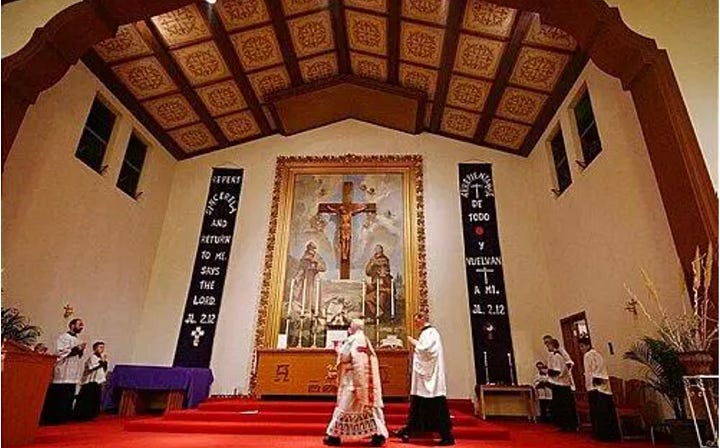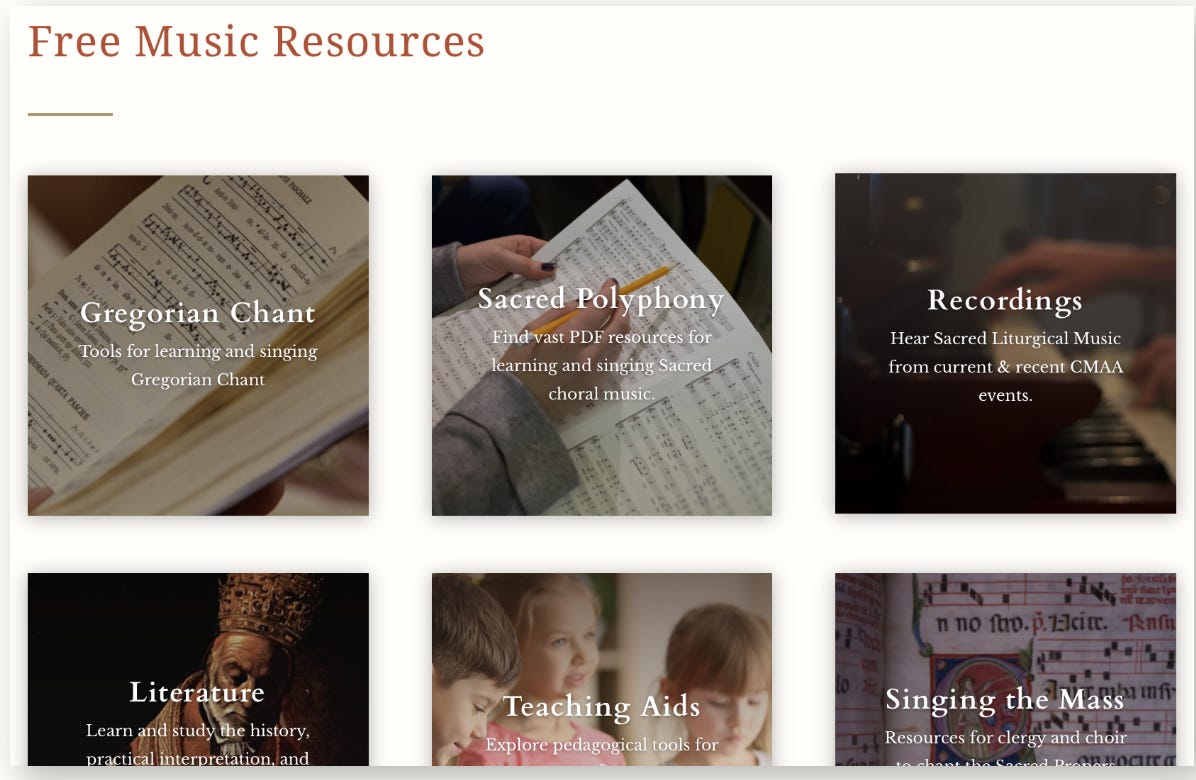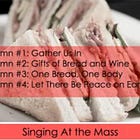What Can You Do to Improve Sacred Music at Mass?
Sharing some tips from Prof. Jennifer Donelson-Nowika, founding director of the Catholic Institute of Sacred Music, and pointing you to some helpful resources
Before you scroll down to read about the topic in the headline, take a look first at this opportunity to attend an exemplary Mass on July 4, at the end of the upcoming Fons et Culmen Sacred Liturgy Summit. Registration for the summit is closed, but the public is welcome to this culminating Mass. If you are in the Bay Area on the 4th of July, consider celebrating the Catholic way and come to this Mass. I’d love to see you there.
EVERYONE IS INVITED
ON THE 4TH OF JULY
COME PRAY FOR OUR COUNTRY
IN THIS MONTH DEDICATED
TO THE SACRED HEART
AT A SOLEMN PONTIFICAL
VOTIVE MASS OF THE SACRED HEART
Friday, July 4, 2025 – 6:00 p.m.
The final Mass of the Fons et Culmen Sacred Liturgy Summit will be celebrated at St. Francis of Assisi Church, 1425 Bay Rd. East Palo Alto, CA 94303.
The Solemn Pontifical Votive Mass of the Sacred Heart will be celebrated by Abbot Marc Crilly, O.S.B., who is music director at St. Benedict Abbey, Still River, Harvard, Massachusetts. (I’ve visited that peaceful abbey in an oasis of rural Massachusetts beauty a number of times, when I traveled back East to visit my sisters and their families in the Boston area. In 2013, I wrote “Winter at St. Benedict Abbey” for the now-defunct Regina Magazine.)
At the July 4 Mass, the professional ensemble assembled by the Catholic Institute of Sacred Music (CISM) will sing Frank Martin’s spectacular Mass for Double Choir, along with motets by Tomás Luís de Victoria and Frank La Rocca.


Masses You Attend Need More Beautiful, Reverent, Sacred Music. But You’re Not in Charge. What Can You Do?
Much is being written lately about how reverent sacred music at Mass helps lead people's hearts to recognize Christ in the Eucharist. After many decades of experimentation with other types of more-secular sounds of music, recent experience shows that restoring sacred music patterned on the traditional music of the Church can bring about a renewal of vitality and growth in Mass attendance and is a proven aid to evangelization.
What can you do if you are convinced that better sacred music is needed where you attend Mass, but you are not in charge? The suggestions in the article were developed in conversation with Dr. Jennifer Donelson-Nowicka, Professor at St. Patrick’s Seminary and University in the San Francisco Archdiocese, vice-president of the Church Music Association of America (CMAA), and founder of the Catholic Institute of Sacred Music (CISM).
How to Frame Things for Your Priest
One important thing to remember, Dr. Donelson-Nowicka points out, is that pastors, rectors, chaplains, or abbots are very busy. (For the rest of this article, “priest” means any ordained leader who makes decisions about the music.) Far too often, people come up to their overworked priests about things they are adamantly sure need to be changed: “Somebody should blah, blah, blah.” Donelson-Nowicka calls them “job-identifiers.” Priests don’t need any more confrontative “job identifiers.”
What priests need is to have people on their team. The first and most important way to be on your priest’s team is to pray for him.
Next, you should support and affirm him, especially in his strengths, by complimenting him when he sings well at Mass or telling him when something he does to ensure Mass is reverent helps you pray.
But you also need to abide with him about things he's kind of just okay at, or maybe even things that he's not so great at.
If you present him with the idea that music needs improvement, be ready with solutions and plans of action. Ensure your words and demeanor clearly show that you respect him and you know he has complete authority deciding whether to do what you suggest.
One effective thing that a regular person in the pew can do is to offer to help, “Father, do you have any particular needs for your music program? Can I volunteer or donate to support those needs?”
How to Inspire Priests, Music Directors, Musicians, and Sacred Music Lovers
“A lot of times, priests and church musicians don't see what is possible in their parishes and schools because they have a limited real experience of amazing liturgies.”—Dr. Jennifer Donelson-Nowicka
Not only priests, music directors, musicians, but also the laity need to experience liturgies where the music is of the highest quality. The professionals in charge also need to be inspired by being in the company of others working to achieve similar goals. To these ends, Donelson-Nowicka recommends attending conferences such as the upcoming Fons Et Culmen Sacred Liturgy Summit being put on by the CISM at St. Patrick’s Seminary in Menlo Park, California, from July 1 to 4, 2025. It’s too late to sign up for that conference, but look out for that kind of event in the future. If you have the funds, you might even offer to pay the priest’s expenses to attend enriching events like that, if he is interested and able to get away.
More Ideas
Here are some other ways people in the pews can support a music program.
You can offer a music director whatever professional training or skills you have that might be useful. Say you're really good at organizing things. Could they use a music librarian? Do they need public relations help? Do they need help with a music program fundraiser that won't detract from other parish fundraising? Could they use technical support for social media? Perhaps you can offer to cook for a reception after sacred music events, to build fellowship.
Does the music director need someone to correspond with people and keep people in touch, perhaps through an email management app? Or to send out greetings on members’ birthdays . . ..?
You can ask similar questions of a music director that you might ask a priest, such as, “Do you have some initiatives on which you need help or donor support?
Music directors and musicians need professional development. True, that has to be built into their contract, and you, as a regular pew dweller, can’t affect that. But you could pay their way to attend events and conferences that can make them better musicians and give them more support in their work.
For professional development, the CISM also provides graduate-level coursework in a well-attended summer program. CISM also offers an online workshop series, many popular public lectures, and concerts.
“We have a top notch world-class faculty, people who really know theology, who really know liturgical theology, the history of the liturgy, people who really know scripture, people who really know ceremonial, and people who really know how to sing chant, how to conduct chant, how to teach people to sing generally and to sing chant in particular, how to run a great rehearsal, how to build up a music program in terms of thinking about fundraising or organization or starting an organ project
.When people study with us, we build them up in those skills.”—Dr. Donelson-Nowicka
Scaling the Heights with the Help of Others
Dr. Donelson-Nowicka: “One of the things that we're doing with the Fons et Culmens Sacred Liturgy Summit [and other similar events] is providing people a mountaintop experience. When we share experiences shaped by the utmost that we can muster in terms of liturgical celebration, preaching, amazing music, the best talks—that sort of experience produces a number of important spiritual results that we see as a need for people today.”
Offering to send a priest, music director, or musician to an event like that would be a great gift. You're not only giving them inspiration, but you're also giving them an opportunity to interact with others working towards similar goals.
“One of the things I enjoy most about being in the sacred music world is learning from other people. Going to conferences and other events, I learn what other people are doing and am inspired.”—Dr. Donelson-Nowicka
To learn more about the offerings of the Catholic Sacred Music Institute, click here.
To learn more about the CMAA, click here.
“The Church Music Association of America was formed in 1964 as the Second Vatican Council drew to a close, as the coming together of the American Society of St. Cecilia (founded 1874) and the St. Gregory Society (founded 1913), and it inherits the rich history of these organizations. Their amalgamation in 1964 began a new chapter in the history of American Catholic music.— From the CMAA About Us > History page.
Note that their annual Sacred Musical Colloquium is coming up June 25-28, and registration is still open.

With a wealth of organizations offering conferences, classes, and resources, I can’t cover them all, but here’s another great one. Corpus Christi Watershed is a popular website that has been supporting sacred music directors and musicians since 2006. This article is a helpful guide to resources available at the site: 4 Ways to Use Corpus Christi Watershed.
In 2014, I wrote Love, Marriage, Babies, and Missals after interviewing Jeff and Cynthia Ostrowski, the couple who founded CCW, which was published in the now-defunct Regina Magazine.
To learn more about the history of singing during Catholic Masses before and after Vatican II, and about some of the debated issues, check out this article, which was originally published at Homiletic and Pastoral Review.
If you have questions about this topic, please ask them in the comments. Or, if you get this post via email, you can send questions to me by hitting Reply. But, it’s better to put them in the comments, because others may have the same questions. And comments build discussion, and discussion builds community.





From email Jun 8, 2025, at 12:47 PM:
Hi, Roseanne! The choice of sacred music is an issue that applies to
more than just Catholicism. For example, I have heard straight-up
African-American gospel music in Jewish religious services and also
religious texts sung to the tune of popular songs -- Leonard Cohen's
"Hallelujah" tune has been trending lately.
Anyway, my only suggestion for you, based on my study of music history,
is to check out the Medieval masses based on "L'Homme Armé," which was a
popular song at the time, about a highwayman (talk about "bad people
doing bad things"!). Per Wikipdeia, "over 40 separate compositions
entitled Missa L'homme armé survive from the period." Using popular
songs in sacred music is way older than Vatican II.
I replied:
Dear Cousin-in-Law,
Thanks for your comments, from a Ph.D. in Music, no less. I'm delighted you are reading my Substack articles.
L’Homme Armé must have a catchy melody. It sure caught the attention of 40+ composers, and it looks like composing Masses using that tune became a kind of fad.
The issue I’m discussing in this article is not that popular tunes are being used in sacred music.
It is an issue in other articles I’ve written, when the dumbed-down sometimes even heretical hymns used at most Masses after Vatican II were set to dumbed-down melodies. And hymns, often banal ones, replaced the singing of the actual words of the Mass. I wrote about that in "Propers of the Mass vs. The Five Hymn Sandwich" here: https://roseannetsullivan.substack.com/p/propers-of-the-mass-vs-the-four-hymn
Did you ever hear that a lot of traditional musicians have made a lot of fun of one Mass setting written after Vatican II that sounds a lot like the music for My Little Pony? Here's a link to a post about it.
https://www.ccwatershed.org/2014/08/27/dan-schutte-mass-of-christ-the-savior-2/
BTW, I was amused when I saw a video one time showing the secular songs that Handel reused the melodies from in his Messiah. The secular song was played next to the song from the oratorio, and the identity of the tunes was undeniable.
My discussion in this article is about how to help get the kind of music into your local Masses that the Church teaches is fitting for the liturgy.
Thanks for writing. It’s good to hear from you.